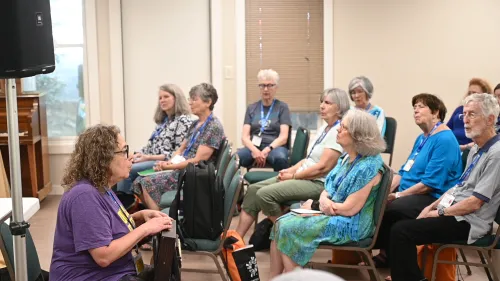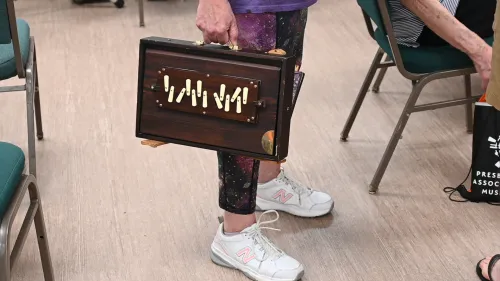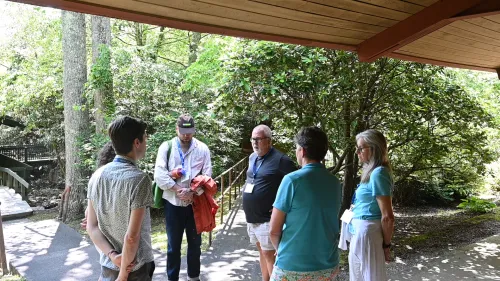A shruti box helps unleash a classroom of creativity
Ana Hernández is the Routley Lecturer at the Worship & Music Conference

MONTREAT, North Carolina — With a shruti box at her feet, Ana Hernández, the Routley Lecturer during the Worship & Music Conference last week and this week, elicited some beautiful tones from her students during the classes she held at Montreat Conference Center.

Originating on the Indian subcontinent, a shruti box works on a system of bellows. Similar to a harmonium, it provides a drone that voices can match while building melodies. Adjustable buttons allow for tuning. It’s the size of a small briefcase.
“It comes with a foot pedal so you can play guitar and shruti box, which I think is a blast,” said Hernández, a composer-arranger, recording artist, song leader, an activist for peace and justice, retreat leader and author whose books include “The Sacred Art of Chant.” “All I have to do is remember to keep the pedal going.”
She recalled an arts camp she taught at a few years ago. “Everyone was talking about [one participant], Dylan, and how to manage him,” Hernández recalled. He had ADHD and was “off the charts intelligent.” She encouraged him to walk around the classroom “but don’t go where I can’t see you.” She took out the shruti box and began to play. Dylan appeared from behind a pew and asked her what she was playing. After she told him, she asked him, “Do you want to play it?”

“I showed him for a minute, and he played it perfectly. He settled right into it,” Hernández said. “Its superpower is chilling you out when you’re anxious.”
With help from her shruti box, Hernández put her 30 or so students to work, picking a note and humming it for a while. “When you get comfortable on your note, start moving around,” she suggested. “You guys sing this note,” offering up higher notes in the same chord to other groups in the room. “Now go down a half-step. Now go back up, because it hurts,” she said with a grin. “See how much fun we can have with music? It can be gorgeous and all of a sudden it’s like, whoa!”
Hernández suggested that when students returned to their churches, ask “an intrepid choir member” to sing a well-known psalm, such as Psalm 51, while other choir members drone a particular note during worship. “It could be anything,” Hernández said. “Just turn that intrepid choir singer loose.”
Hernández divided the class into groups of five or six, asking each group to select a drone and a fifth, fourth or minor third. Group members sang a familiar song or the Lord’s Prayer while the others hit their note.

While students were creating, Hernández spoke to Presbyterian News Service.
Her goal for the week was to help people “find a deeper way to pray and also have more fun praying — but not just praying, that they loosen up and are a little more comfortable being with one another doing things they don’t know,” including “a little improv, stumbling into a something beautiful and going with it” and “failing fast” and moving on. She leans on this Virginia Woolf quote: “A self that goes on changing is a self that goes on living.”
She’s helping students answer these questions: “How can we make sure we are actually praying when we’re singing? How can we be present in the prayer, and not worrying about the notes?”
“We find ourselves not present to the thing, and it happens in all facets of life,” she said. “Everyone knows how to [pray through singing], but they forget they know. … Most of it is giving people songs they can carry with them.” Hernández has been collecting such songs for more than 30 years.
After each group presented what they’d composed together, Hernández told a story that illustrated just how spontaneous the creative process can be. She taught students a song she composed in the car on her way to a conference. It included the lyrics, “hold my hope, hold my trembling, hold my heart, teach me to be love.”
“I do these prayer chants, but I had nothing that morning,” Hernández said. “I parked the car for a minute and thought, what do these people need to know? What’s a good prayer? ‘Hold my hope, hold my trembling, hold my heart, teach me to be love.’ I got there and handed out the parts, and I knew it wasn’t me. It’s easier in a circle, because you’re singing across to someone. … I’ve had it crash and burn only a couple of times.”
Hernández teamed with classically trained singer Ruth Cunningham, a founding member of Anonymous 4, to release two CDs of multifaith chants. “She was not used to improvising at all, but she has a gorgeous voice,” Hernández said. Ahead of their time in the studio, Cunningham practiced improvising to both piano and harp. “She got it,” Hernández said. “I just aim for beauty and something happens.”
In the studio, the two recorded “Saranam,” a lovely lullaby, in just two takes. “We just had an idea of where it was going,” Hernández said. “We had a bunch of chants, and so we started doing evening gigs.”
You may freely reuse and distribute this article in its entirety for non-commercial purposes in any medium. Please include author attribution, photography credits, and a link to the original article. This work is licensed under a Creative Commons Attribution-NonCommercial-NoDeratives 4.0 International License.




